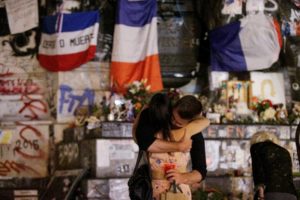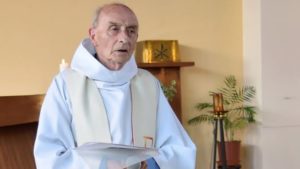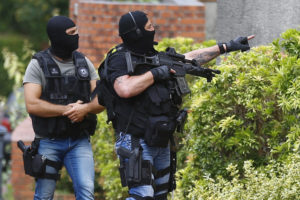A year-and-a-half ago, along with a million other people, I spent a cold January afternoon marching in the streets of Paris to show indignation and determination that terrorism would not prevail. That was after the first Islamic attack in Paris, against the staff of the satirical newspaper Charlie Hebdo and customers taken hostage in a kosher grocery – sixteen dead in all. For the record I was not “Charlie” as the slogan of the day went, referring to that despicable obscene rag, but simply convinced – as a citizen – that coldblooded killing, even of obnoxious people working at their desks or others buying groceries for their families, was intolerable.
The mood that day was universally shared: we don’t want any part of this violence, we are strong, life will go on. Clear determination appeared on every face, solidarity was a buzzword, “we are not afraid” the prevailing message.
Ten months later came the November attack, teams of Islamic fanatics slaughtering friends having drinks or dinner at sidewalk cafes on an unseasonably mild Friday evening, and fans inside a theater for a rock concert. The public mood this time was numb shock and wide-eyed horror at the sheer numbers of dead (130) and wounded (351). Determination still dominated, but a (not always) silent questioning began. What is really being done since, obviously, it’s not effective?
And then Nice: a 20-ton truck transformed by an Islamic madman into a weapon against a tightly-massed crowd of families out for a summer evening to watch fireworks on the most fundamental French national holiday (84 dead, 286 injured). This time, the mood changed noticeably. Impatience and anger replaced resignation and the usual calls for “national unity.”
People now carried signs that, instead of proclaiming “solidarity together” said “we are fed up.” The new question: “How many more times must we go through this ritual?” When the Prime Minister and several of his other ministers appeared in Nice a few days later, they were greeted with jeers and cries of “murderers” and “resign.” Police, firemen and other security agents present were, by contrast, roundly cheered.
And now, less than two weeks later, a Catholic priest vested at the altar, surrounded by his faithful as he celebrates morning Mass, has his throat slit, accompanied by too familiar jihadist cries. This unspeakably blasphemous act took place not in a well-guarded city, but in Saint-Etienne-du-Rouvray, a small quiet Normandy town.

The horror has now been taken to a dizzying new level. For Catholics, but not only for them, the circumstances are repellent but also instructive – and prophetic. A revered priest, Père Jacques Hamel, has his own blood literally mingled with the Precious Blood he consecrated on the altar.
The first attacker could be easily identified. He was well known to authorities – police recognized his face – for extremist acts and convicted twice after two unsuccessful attempts to rejoin ISIS in Syria. But he’d been released on probation.
Archbishop Dominique Lebrun of Rouen made a brief statement on television from World Youth Day. His measured calm helped fill the emotional void we were experiencing after the initial shock: “The Catholic Church can take up no other weapons than prayer and brotherhood among men. I am leaving here hundreds of young people who are the future of humanity, true humanity. I ask them not to give up in the face of violence and to become apostles of the civilization of love.” He then left Krakow to return to Rouen.
There had already been an attack planned on a Catholic church in April 2015. It failed only because of the incompetence of the would-be assailant, who shot himself in the leg en route. I’ve thought of the possibility, indeed the likelihood, of a Catholic church as a target for Islamic terrorists. Sometimes when I assist at the noon mass in my unassuming parish church in a tranquil residential neighborhood in Paris, our vulnerability crosses my mind. The church doors are wide open, the altar is visible from the street, mass is at the same hour every day. We too have an elderly pastor, and a congregation during the week of about twenty or thirty. But I try to pray, assuring myself that, if I should die here and now, it’s not the worst way to go.
Now that a church attack has taken place – not in some distant Middle Eastern land but in the heart of France – with Islamic jihadists claiming revenge on an infidel “crusader” during a Eucharistic celebration, ancient buried memories begin to stir. France proudly declares itself officially “laique,” secular, with no preference for any religion, indeed a constitutional indifference to all. In truth, this often is code language for official atheism, and at its worst anti-religion.
But the slaughter of a priest, a man of God, while he is accomplishing the sublime act of his sacerdotal mission, has provoked an involuntary reaction. Deep-rooted sensitivities, perhaps long forgotten, perhaps willfully repressed, have, consciously or unconsciously, sprung to the forefront. Even Saint-Etienne-du-Rouvray’s Communist mayor wept for the murdered priest. Barely able to pronounce his words, as he fought back his tears, he barely managed to gurgle out, one painful word at a time. “It is imperative that the unbearable not happen again. Let us stand together to be the last ones to have to grieve and together as the last ones standing firm against barbarity, with respect for all.”

The ancient Catholic roots of this eldest daughter of Holy Mother Church are mostly desiccated. France will not be miraculously reconverted overnight, but recognition of the country’s long-repressed historical roots in Christianity could turn out to be a pivotal moment. The blood of martyrs penetrates deeply, reawakening a need, a desire, a hope long buried but not totally extinguished. Could it be this drop that indeed makes the cup begin to run over?
The day after the abominable attack, I attended the memorial Mass at Notre Dame. Security was draconian, starting more than two blocks away. All streets were blocked to vehicle traffic and pedestrians were carefully screened, a total of three times, before finally being allowed to enter. The cathedral was packed, and the front rows were reserved for members of government, ambassadors, and assorted dignitaries. Cardinal André Vingt-Trois, crosier in hand, was waiting at the great central portal whose double doors are only opened on exceptional occasions.
At precisely 6:10, the Catholic cardinal welcomed the secular president into his cathedral and personally escorted him the length of the great nave to his seat of honor in the front row. The cardinal then returned to the sacristy to join the grand solemn procession with numerous concelebrants. In his imperturbable manner, he preached a quietly courageous and thoughtful sermon (not lacking political overtones), based on hope as a weapon against hate and the ultimate confidence in the love of a God of life and not death. Unusually, he was warmly applauded when he concluded.
Archbishop Lebrun, during the Eucharistic prayer, asked God’s peace for his martyred priest, and added, his throat constricted but his voice firm, “I dare also to pray for his assailants; Lord, bring them too into your peace.”
Overall, an hour-and-a-half of the moving beauty and solemn majesty of a grand Catholic liturgy. Within that magnificent 850-year-old sacred edifice, I couldn’t help but think of the millions of people who have come there to worship this same God, in as bad or even more troubled times.
Since January 2015, we have become accustomed to armed soldiers patrolling the streets, the metro, train stations, the large square in front of Notre Dame. We now automatically, even gratefully, open bags and coats for inspection at the entrance to big stores and shopping centers, to museums, to theaters. We instinctively know such measures are intended to be reassuring – even if they’re not strategically effective.
It’s not well known abroad that there have been numerous equally blood-chilling Islamic horrors in this country (since 2012, 10 attacks, 5 known foiled attempts). They’ve often been less mediatized because of fewer victims or because the perpetrators failed (e.g., a factory owner decapitated by an employee, the foiled shooting on the high speed Amsterdam-Paris train). After each attack, the familiar rituals are set in motion. Tears flow, flowers and candles pile up, a moment of silence is observed, flags are set at half-mast, official declarations come from all sides.

Although terrorist acts are by nature unpredictable – and so, up to a certain extent, unpreventable – common sense, and a growing slice of public opinion, recognizes that merely repeating “everything possible has been done” is not enough. Laying flowers and lighting candles while singing the Marseilleise no longer suffice (and never did), neither to reassure uneasy citizens, nor to counter unbridled hatred growing like a cancer in this society. Increasingly the public is calling for firm and determined action.
But also after every incident (the most recent ones being no exception) we are regularly instructed (actually lectured to) by civic authorities not to lump together a few misguided miscreants with the rest of the Muslim population. “This crime (or attack or atrocity) has nothing to do with Islam,” is the solemn refrain.
However, it’s not the role of the (constitutionally secular) president or his prime minister or any other civil authority to pontificate on what is or is not an integral part of Islam. Islamic leaders have the authority to designate criminal acts as incompatible with their faith, and also have the obligation to police its adherents, filtering out deviant doctrine, closing openly Salafist mosques notoriously financed from abroad, where non-French Imams preach jihad and hatred of European infidels.
I am neither hopeful nor optimistic that there can be a rapid and antiseptic solution to this widespread gangrene. Nor am I alone in my pessimism. We think of it all the time, we are surrounded and immersed in it, we are reminded of it everywhere. People are watchful, vigilant in public. A fellow with a large backpack and a nervous manner gets on the subway, and everyone has an eye on him.
But sidewalk cafes once again have customers enjoying a drink and a chat. Parisians still go to movies, sporting events, concerts – the controls are ratcheted up a notch with each new event. A determined resignation has taken charge. Tourism, a prime element in the national economy, has nosedived since the November attacks. The events of the past two weeks could be fatal to that sector, at least for this year’s vacation cycle.
And we know all too well these are not the last. What form will the next one take, for jihadist imagination seems boundless in sowing death and terror? We watch horrified (but also mesmerized) as madness explodes not just in Paris or in Nice, but in Brussels and Istanbul, German cities and elsewhere. It erupts not just in large metropolises but in quietly peaceful little towns. Two months ago two police officers, a married couple, had their throats slit by Islamic jihadists, at home in front of their three-year-old son, in a tranquil suburb forty miles from the capital.
You just keep hoping that when the next one does happen, you can manage, by the luck of things, not to be in the wrong place at the wrong time.















